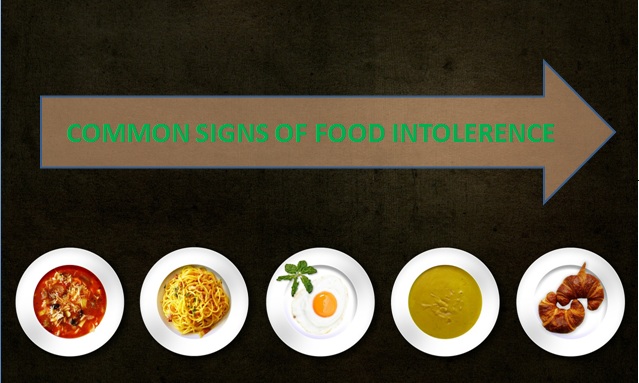Let me ask you a question. In the morning, when you wake up, do you leap out of bed full of energy ready to take on a new day?
Or do you dread hearing the sound of the alarm clock, struggle to open your eyes, and then slowly stumble your way to the bathroom still half asleep?

If you are like most people, you probably hate getting out of bed in the morning and have got so used to feeling groggy and tired when you wake up, that you just assume it’s normal.
What you probably didn’t realize, is that this is a classic symptom of a food intolerance or food sensitivity as it’s sometimes called.
How Does Food Intolerance Develop?
When you put something in your body that’s poisonous, harmful or simply not suited to your genetic makeup, your body sounds an alarm signal to tell you to stop what you are doing.
This “alarm” can come in the form of a headache, feeling sick or even just a bad taste in your mouth.

If, however, you ignore these warning signs and keep on putting the same thing in your body, then eventually, your body gets used to it and stops sounding the alarm. One of the best examples to illustrate this is smoking.
When people first start smoking they often cough or feel faint. These are the first alarm signals and the body’s way of saying “hey, this is no good for me, stop it!”
At this point, most people will listen to their body and not smoke another cigarette. But for those who do continue to smoke, their body will eventually get used to the cigarettes and soon they will be able to smoke without any apparent adverse effects.
If a person has been smoking for long enough, they will begin to experience withdrawal symptoms when they haven’t smoked and will start to feel unwell as a result.

This occurs because the body has become so used to receiving the poisons found in cigarettes, that it now believes it needs them in order to survive.
If that person smokes again during their withdrawal period, the body will get what it “needs” and the withdrawal symptoms that person was suffering from will quickly go away.
Eventually, however, there comes a point when the body can no longer tolerate the poisons that cigarettes contain. When this happens, the smoker will begin to notice adverse health effects that occur gradually over a period of time with increasing severity.
The General Adaptation Syndrome (GAS)
In the medical world, the process of alarm reaction, resistance and exhaustion that we have just described, is known as the General Adaptation Syndrome (GAS).
It describes how your body tries to warn you when you are doing something harmful, how it can tolerate that stress for a certain amount of time, and how eventually it starts to break down because it can take no more.
This idea comes from the scientist Hans Selye who studied how rats responded to stress. He found that when exposed to a stressor (i.e., something that causes stress), the rats became agitated and were clearly disturbed in their environment.
But after a while, the rats soon adapted to the stress they were under and resumed their normal behaviors. Eventually, however, continued exposure to the stressor resulted in the death of the rats.

The same thing that happens with cigarettes can also occur with the foods you eat. Only this time, instead of being affected by chemicals in cigarettes, your body is affected by chemicals in certain types of foods.
If you suddenly stop eating these foods, you start to suffer from withdrawal, and so just like the smoker, you will begin to crave something that is actually harmful for you.
Most of the time, this process begins in early childhood. Although, it can also occur at any stage of life as a result of eating foods which you are genetically intolerant to. The best way to think of this type of intolerance is by comparing it to a food allergy.
Some people will suffer an adverse reaction after eating a food, say, an avocado, whereas others can eat the same food without having any problems.
The reason for this is because we are all genetically unique, and so different people can react differently to different types of foods as a result of their genetic makeup.

Food intolerance (i.e., a food that causes an adverse reaction in your body), however, is different to a food allergy, because its initial effects, the alarm reaction, tend to be much more subtle.
Instead of making you feel sick or struggle for breath, for example, you may not notice any immediate symptoms.
As a result, the symptoms that you eventually do experience (e.g., nausea, bloating, feeling sick, brain fog, stomach pains, blurred vision, skin rash, headache) are unlikely to be associated with the food you previously ate or drunk.
Add to this the fact that certain chemicals in foods, both natural and artificial, are known to be addictive, and it’s quite easy to see how a person can continue to eat a food that they are genetically intolerant and which is doing their body harm.
Note: Food intolerance tends to be caused by digestive disorders such as not having the right enzymes to digest a food properly (e.g., lactose intolerance), or an intolerance to something that a food contains, such as histamine or an artificial chemical such as aspartame. Food allergies, however, are immune system based.

When a person reaches the exhaustion stage and their body can no longer tolerate the food that it is intolerant to, they will start to suffer health problems.
Typically, this occurs when a person reaches their 30s, 40s or 50s, but sometimes, it can happen when a person reaches their 20s or even late teens.
How soon a person reaches the exhaustion stage can vary, as this largely depends on their overall genetic makeup, the type of food they are eating, how intolerant they are to a food, and the frequency at which they eat that food.

But one thing is sure, if you continue to eat something that you are genetically intolerant to, then there will come a point when your health starts to become affected by it.
Most of the time, people will attribute these adverse health effects to the natural aging process. But when the real cause is discovered, it almost always comes down to their diet.
Food Withdrawal Symptoms
One of the things that makes food intolerance so deadly to live with, is that the foods you are intolerant to, you are most likely already addicted to. This means that when you don’t eat those foods, you will start to experience symptoms of withdrawal.
Some of the most common of these symptoms include: headaches, irritability, mood swings, lack of concentration, fatigue, nervousness and feelings of depression.
As a result of these withdrawal symptoms, you learn to associate pleasure with the foods that help to alleviate your withdrawal. This means that, over time, you become motivated to eat them on a regular basis.

Most of the time, withdrawal from food is most noticeable in the morning. As by the time you wake up, it has been 12-14 hours since your last meal which is more than enough time for withdrawal symptoms to appear.
This is why it’s quite common for someone to wake up feeling groggy, tired and irritable in the morning, as throughout the night, they have essentially been undergoing a prolonged period of food withdrawal.
When they eat their breakfast and get their fix of coffee, wheat and milk, they end their withdrawal and their mood starts to pick up again. The trouble is, many people never associate how they feel in the morning with the foods they eat.
As a result, they can continue for many years eating foods which they have a genetic intolerance to.

Some of the most common food intolerances that people have include foods containing sugar, wheat, dairy and caffeine. All of these can cause a variety of symptoms in the body once a person enters the exhaustion stage of the general adaptation syndrome model.
For example, sugar can lead to candida, excess weight gain and insulin resistance. Wheat can cause respiratory or joint problems. Dairy can cause joint or stomach problems. And caffeine can cause adrenal fatigue and premature aging.
These symptoms will get progressively worse as a person ages, although, the very first signs normally appear during your late 20s to early 30s.

What this basically means, is that the foods which are bad for you are also probably the foods, or drinks, that you crave the most. This is why food intolerance, and the subsequent food addiction that it creates, can be so difficult to overcome.
As once an addiction has taken hold of you, it invariably leads to habitual patterns of behavior which then makes you eat those bad foods on a consistent and regular basis.
Testing For Food Intolerance
The large majority of people have a food intolerance which do not know of. This is usually related to a wheat based food such as bread or beer, or a dairy based product such as milk or cheese.
Finding out exactly what foods you are intolerant to, however, can be difficult. This is because the only way you will know for sure what you are intolerant to, is by undergoing a test for food intolerance or by trying to figure it out yourself through trial and error.

Furthermore, because we all react differently to foods, you can’t just assume that what someone recommends as a good healthy diet, is in fact going to be good and healthy for you.
Tomatoes, for example, are generally thought of as a healthy natural food. But for some people, eating a tomato can cause them to develop skin disorders or arthritis.
So if you are suffering from any kind of health problem, or if you have a family history of disease, then it’s vital to examine the types of foods you eat on a regular basis no matter how healthy you may consider them to be.
Withdrawal symptoms from intolerant foods normally take about 5-7 days to pass. So unless you are specifically trying to find the foods that you are intolerant to, you probably won’t find out until they start causing you noticeable health problems.
If you want to find out sooner than this, below are listed some of the things that you can do:
1) Food Intolerance Tests
A food intolerance test can be done at home or carried out professionally, via a stool, blood or breath test, in a laboratory. Lab tests are the most accurate, but they are also the most expensive, and so many people choose to test for food intolerance at home.

If you are testing yourself at home, you will find that some kits can give very good results. Other kits, however, usually the cheaper ones, can produce false positives which means that you will be told that you are intolerant to a food when you are not.
Food intolerance tests are currently the most accurate way to determine food intolerances, and will help you to pinpoint problems foods that you can then try eliminating from your diet one by one.
2) Fasting / Elimination Diet
Fasting is another way to test for food intolerance, and can be very effective providing you know what to look out for and have some experience of fasting.
It’s important to note though, that fasting can also be very dangerous and so it’s not something that you should rush into unprepared.

Fasting can help you test for food intolerance because it cleanses, or detoxifies, your body of the foods you normally eat. This then allows you to go through a period of withdrawal while your body is being cleansed.
After this process has occurred, which will normally take about 5-7 days, you can then gradually reintroduce foods back into your diet to see what sort of an effect they have on you.
This, however, is a long process, and one that requires a tremendous amount of self-discipline to do.

If you want to try fasting, you may find it helpful to keep a food diary so that when you do start eating again, you can record how you feel after eating a particular food.
Remember though, that some effects may not appear for several days after a meal. So in order to get accurate results from your fast, you should eat only one type of food for a week or two before introducing another food back into your diet.
During your fast it’s also a good idea to do a colon cleanse. This is because the length of the withdrawal symptoms that you experience are largely dependent on how long food rests in your bowel. So if you are constipated, your withdrawal symptoms will last longer.
3) Food Cravings
The foods that you are most intolerant to will likely be the foods that you crave on a daily basis. So make a list of the foods you crave the most, or feel as though you could not live without.

Think of the foods that you absolutely have to eat every day, and which if you did not eat, would put you in a bad mood, make you feel tired, or make you unable to concentrate.
Once you have drawn up your short list of foods, try excluding them from your diet for a period of no less than one week. Or, if you do not have regular bowel movements, for a period of two weeks.
This can be quite an effective way to determine food intolerances, but at the same time, can also be very hard to do as you will have to fight your cravings and addictions in order to succeed.
What Can Trigger Food Cravings?
Although it can take 7-14 days for withdrawal symptoms to disappear once you stop eating a food that you are addicted to, it can take up to one year for food cravings to completely go away.
Unfortunately, as long as these food cravings remain, dieting and losing weight will be much harder for you.
However, there are certain things that can trigger food cravings, and once you are aware of them, you will be much better equipped to deal with them and prevent future cravings.
This should then help you to stick to your diet, and eventually, lose the weight that you have been trying to shift as well as improving your overall level of health.
Two of the most common things that can trigger food cravings are chemicals and low blood sugar levels. Let’s have a brief look at each of these now:
1) Chemicals
We are exposed to numerous chemicals every day, and some of these chemicals can cause us to crave certain types of foods. These chemicals can be found in traffic fumes, crop sprays, cigarette smoke, household cleaning products, and even in cosmetics.

Interestingly, the average woman absorbs around 1 kg (2 pounds) of cosmetics through her skin each year, which is the equivalent of about one large bag of sugar.
This is from only one source, so you can imagine how many chemicals we actually absorb from all the sources of chemicals that we are exposed to!
Furthermore, chemicals may be added to food to make them more tasty. Food additives, such as monosodium glutamate (MSG) or high-fructose corn syrup, for example, can make foods very pleasurable to eat, and therefore, very addicting!
2) Hypoglycemia
Hypoglycemia means that you have low blood sugar/glucose levels. As the brain needs glucose to use as a source of fuel, when glucose levels are low, the brain can make you start to crave sugary foods so that it will have energy to run itself with.

Unfortunately, the high sugar foods that you now crave are also probably the very same foods which you are trying to avoid. This is why so many people break their diet with a candy bar or piece of a cake.
The best way to deal with hypoglycemia is to tackle it before it occurs. This can be done simply by making sure that you are eating properly and often enough throughout the day, as this will prevent your blood sugar levels dropping to the point where they start to cause you to crave food.
The Body Load
Whilst it’s true that certain foods can, for certain people, produce harmful effects in the body, the good news is that you don’t have to eliminate everything that’s bad from your diet.
This is because the body is designed to deal with some amount of stress, and it’s only when the body gets overloaded with toxins that it starts to break down and develop disease.

This is known as the “body load”, and the first thing to be affected are your organs. Some of the most common organs to be affected are the brain (depression), the skin (rashes) and the bowel (diarrhea).
So as long as you can lower the burden on your body to below the body load threshold, you can, occasionally, treat yourself to junk foods even when you are dieting.
Be careful though, because if you were once addicted to those foods then you could very easily become addicted to them again. So be very selective over the foods you treat yourself with, as otherwise, you could just end up causing yourself more harm in the long run.
Videos
Reviewed – 27th March 2016
